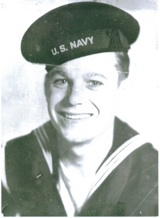From Illinois Militia to U.S. Navy – A Vet’s Story
Seventeen-year-old Harlan G. Johnson enlisted in the U.S. Navy in World War II after being rejected by the Army. He was on board the USS Mullany (DD-528) at Okinawa when it was struck by a Japanese kamikaze plane on April 6, 1945. Major Chris Heatherly recently interviewed him about his experiences. This portion of the interview covers his early experiences in the Illinois Militia and the U.S. Navy; the second part explores his experiences in combat.
Chris Heatherly – Tell me about your life before you joined the Navy.
Harlan Johnson – I quit school in the 8th grade to work at Sargeants Feed Mill in Monmouth during the depression. Many kids didn’t go on to high school at that age. I was also in the State Militia that met at the Monmouth Armory for about one year. The militia was made up of kids and old men. Younger men were only in the militia if they held a job important to the war effort or failed the military physical and were classified 4F. We wore uniforms at drill, marched everywhere, and drilled with the M1903 rifle. We also fought a flood at Meredosia. I also participated in drives for scrap metal and rags. We used to put a brick in with the rags to make them weigh more, but they always found it!
 CH – How did you enlist in the Navy?
CH – How did you enlist in the Navy?
HJ – I went to the Army recruiter first, but he wouldn’t take me because I wasn’t 18 years old. I went to the Navy next and my mother signed for me. She asked the Navy recruiter if I would go overseas. He said that I wouldn’t for at least one year. After that I went to Springfield, Illinois, for my physical. I almost failed because I had flat feet.
CH – Where did you attend basic training?
HJ – I reported to Great Lakes Naval Training Center for nine weeks of basic training.
CH – What was your training like?
HJ – We marched everywhere. We did tear gas training and a week of mess hall duty. We also did identification training in a dark room where they flashed up pictures of Japanese and German planes for us to identify. I also attended the Mark IV 20mm gun school. The 20mm had a gun site with an offset to lead the plane. It also had a loader and was pretty good at rapid fire, without a lot of recoil. I wouldn’t want to be the guy pulling the target for gunnery! I felt my training prepared me to join the fleet.
CH – What did you do after graduation from basic training?
HJ – I took a nine-day leave in Monmouth first before joining the fleet. I knew I was going to the Pacific. There was a lot more patriotism than I ever saw later. One guy told me to bring back some Jap ears. There was a lot of hatred for the Japanese people. It was the mentality due to Pearl Harbor and the propaganda.
CH – How did you get to California to join your ship?
HJ – We went by train – we called it a cattle car. It had a sliding door like a freight car with windows high up. It was a really hot trip out west and took three or four days to move. We slept on the floor, ate mostly sandwiches and had no shower facilities. We were put on the side tracks for everything. I thought we would have a higher priority. Eventually, I made it to the repo-depo (replacement depot) at Point Montera, California. I caught a bus with about 10 or 20 guys straight to the USS Mullany. This was the last time I marched in the Navy.
To read about Harlan Johnson’s experiences at sea, including the kamikaze attack at Okinawa, click here.


0 Comments
Trackbacks/Pingbacks